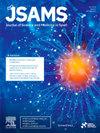高强度疲劳跑是否会影响下肢受伤风险?
IF 3
2区 医学
Q1 SPORT SCIENCES
引用次数: 0
摘要
研究目的本研究旨在量化中长跑速度下高强度跑步至疲劳时胫骨远端弯曲力矩峰值、髌股关节接触力峰值和跟腱力峰值的变化:观察研究。方法:16 名高水平跑步者(7 名女性)在跑步机上以之前最大摄氧量测试中达到的最终速度跑步,直至失败(约 3 分钟)。采用三维动力学和运动学方法推导并比较跑步开始、33%、67% 和结束时的胫骨弯矩、髌股关节接触力和跟腱力:平均跑步速度为 5.7 (0.4) m-s-1。从跑步开始到结束,胫骨弯曲力矩峰值有所下降(-6.8%,p = 0.004),这是由于肌肉力量导致的弯曲力矩峰值下降(-6.5%,p = 0.001),而关节反作用力导致的弯曲力矩峰值没有差异。从跑步开始到结束,髌股关节的峰值力有所增加(+8.9 %,p = 0.026),但跟腱的峰值力有所减少(-9.1 %,p 结论:从跑步开始到结束,髌股关节的峰值力有所增加(+8.9 %,p = 0.026),但跟腱的峰值力有所减少(-9.1 %,p = 0.001):以固定的高强度速度跑到终点会导致胫骨弯曲力矩和跟腱力降低,而髌股关节力增加。因此,高强度疲劳跑的神经力学改变可能会增加髌股关节受伤的风险,但可能不是胫骨或跟腱过度劳损的发生机制。本文章由计算机程序翻译,如有差异,请以英文原文为准。
Does high-intensity running to fatigue influence lower limb injury risk?
Objectives
The aim of this study was to quantify changes in peak bending moments at the distal tibia, peak patellofemoral joint contact forces and peak Achilles tendon forces during a high-intensity run to fatigue at middle-distance speed.
Design
Observational study.
Methods
16 high-level runners (7 female) ran on a treadmill at the final speed achieved during a preceding maximum oxygen uptake test until failure (~ 3 min). Three-dimensional kinetics and kinematics were used to derive and compare tibial bending moments, patellofemoral joint contact forces and Achilles tendon forces at the start, 33 %, 67 % and the end of the run.
Results
Average running speed was 5.7 (0.4) m·s−1. There was a decrease in peak tibial bending moments (− 6.8 %, p = 0.004) from the start to the end of the run, driven by a decrease in peak bending moments due to muscular forces (− 6.5 %, p = 0.001), whilst there was no difference in peak bending moments due to joint reaction forces. There was an increase in peak patellofemoral joint forces (+ 8.9 %, p = 0.026) from the start to the end of the run, but a decrease in peak Achilles tendon forces (− 9.1 %, p < 0.001).
Conclusions
Running at a fixed, high-intensity speed to failure led to reduced tibial bending moments and Achilles tendon forces, and increased patellofemoral joint forces. Thus, the altered neuromechanics of high-intensity running to fatigue may increase patellofemoral joint injury risk, but may not be a mechanism for tibial or Achilles tendon overuse injury development.
求助全文
通过发布文献求助,成功后即可免费获取论文全文。
去求助
来源期刊
CiteScore
7.40
自引率
10.00%
发文量
198
审稿时长
48 days
期刊介绍:
The Journal of Science and Medicine in Sport is the official journal of Sports Medicine Australia (SMA) and is an an international refereed research publication covering all aspects of sport science and medicine.
The Journal considers for publication Original research and Review papers in the sub-disciplines relating generally to the broad sports medicine and sports science fields: sports medicine, sports injury (including injury epidemiology and injury prevention), physiotherapy, podiatry, physical activity and health, sports science, biomechanics, exercise physiology, motor control and learning, sport and exercise psychology, sports nutrition, public health (as relevant to sport and exercise), and rehabilitation and injury management. Manuscripts with an interdisciplinary perspective with specific applications to sport and exercise and its interaction with health will also be considered.

 求助内容:
求助内容: 应助结果提醒方式:
应助结果提醒方式:


